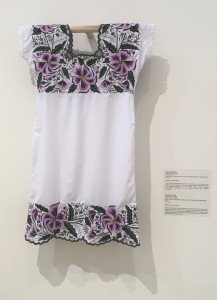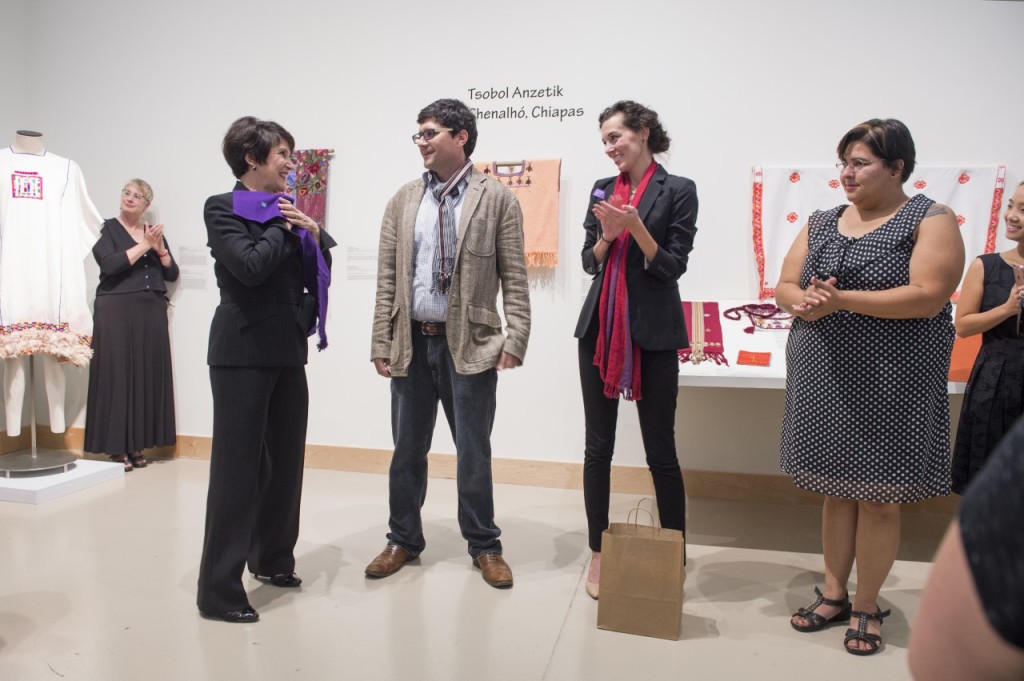You might be surprised to know that there are over 7,000 languages in the world. However, if you think of language like the Maya do, this estimate is way too low.
The Language of Weaving exhibit that’s on display in the Bardo Fine & Performing Arts Center presents woven textiles made by women from four different Maya communities mostly around a town called San Cristóbal de las Casas in Chiapas, Mexico.

Mixed fiber huipil by Norma Bonilla Itzá Photo by Yustin Riopko
Assistant Professor Dr. Paul Worley, Curator of the Fine Arts Museum, Denise Drury Homewood, and two WCU students, Sara Rincón and Alli Rios, traveled to Chiapas in July, 2016. There, they met with people from each cooperative, heard their stories, and started to create a collection of traditional and contemporary woven pieces, including scarves, bags, pillowcases and huipils, a traditional Maya blouse-like clothing article.
Worley and Drury Homewood penned the grant together, and the nonprofit group, Sister Cities International, helped fund the trip’s expenses. In the two weeks that the WCU faculty and students were there, they visited and collected works from the towns of Oxchuc, Chenalhó, and Zinacantán. The exhibit also features works by the Bonilla family from Santa Elena in the state of Yucatán, which were retrieved in part by Hannah Palmer, a doctoral candidate at UNC-Chapel Hill.
Sara Rincón, a WCU fine arts graduate student who went on the trip, finds it to be a good change of pace for a fine arts exhibit.
“Going into art museums, a lot of the work is usually European based,” she says. “That’s cool, but that’s not all there is to see. We have Maya in our area, and they can see their own history, but this is also a way to bring history to people that maybe aren’t aware of it.”
It’s true. Worley confirms the presence of Tzotzil Maya speakers in and around Cashiers as well a large Guatemalan Maya population in Morganton, a city in Burke County, NC. Despite this local presence, however, most people in Western North Carolina probably don’t have much knowledge of Maya culture.
With conscientiously chosen materials, colors and patterns, the selected pieces capture stories and ideas ranging through history, relationships and identity. Subtleties that may seem like casual artistic decisions actually showcase a complex lexicon of ideals held and maintained by the Maya people.
Mayans conceive of writing and storytelling in a broader sense than we do in Western culture. The Maya word, ts’íib, which we often translate as ‘writing,’ means much more in their language.
“These women, in many contexts, are not seen as being artists or intellectuals, because most of them are ‘illiterate,’ but they are highly literate in ts’íib, and highly literate in the context of their own communities,” Worley explains.

The Language of Weaving Reception – Sep. 29, 2016.
Pictured left to right: Susan Belcher, Paul Worley, Denise Drury Homewood and Sara Rincón.
Photo by Ashley Evans, WCU Photography Services.
According to Worley, everyone who gets the chance should visit the exhibit, which he considers a representative example of what students and faculty at WCU can do, as well as a celebration of the Maya, their labor and their knowledge.
The Language of Weaving has been on display since Sep. 12 and will close after Monday, Nov. 7.


